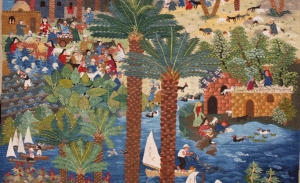The aim of the Centre was to teach Egyptian village children to create art, and tapestries in particular. Ramses Wissa Wassef encouraged the children to weave images based on things they saw around them in their villages, such as women talking, making bread, washing, men working in the fields, weddings, birds, fish and so forth. The ideas of Wissa Wassef became very popular and the range of products was expanded to include embroidered designs. These were not embroideries that required patience, following traditional (often geometric) patterns in a limited range of colours, but spontaneous designs using bright colours and quick stitching.
The Wissa Wassef movement was quickly followed by other groups who set up workshops (both philanthropic and commercial) producing embroideries, rugs, tapestries and so forth, based on the Wissa Wassef format. From Cairo, the idea spread throughout the Eastern Mediterranean and by the 1970's examples of embroideries with daily life scenes from Syria and Palestine started to become widely available on a range of items, such as book markers, bags and cards, as well as large cushions and wall hangings. These forms are still being produced throughout the Middle East at the beginning of the twenty-first century.
Source: MENHEZ, Shahira and Gillian VOGELSANG-EASTWOOD (2016), 'Egyptian Embroidery,' in: Gillian Vogelsang-Eastwood (ed.), Encyclopedia of Embroidery from the Arab World, London: Bloomsbury Academic, pp. 264-293, esp. pp. 270-271.
Digital source of illustration (retrieved 8th July 2016).
GVE

